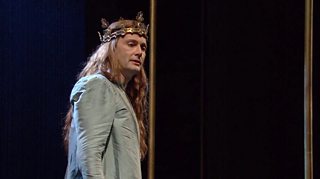Romeo Romeo
Shakespeare’s tragic romance Romeo and Juliet remains one of his most popular and most adapted works across many different art forms, from television and film to music and dance.
Watch and discover how three key scenes from the play (the fight between Romeo and Tybalt, the balcony scene and the death scene) have been interpreted in four varied versions of the play.
These are:
- The ��������'s 1978 television production
- The 2002 filmed version of Gounod's opera Romeo et Juliette starring Roberto Alagna and Angela Gheorghiu
- The 2009 Royal Ballet production with Kenneth Macmillan's choreography and Prokofiev's music starring Carlos Acosta and Tamara Rojo
- The 2016 Pop Up Opera production of Bellini's opera I Capuleti e i Montecchi (filmed in the vaults beneath London's Waterloo station)
-
![]()
Poet, playwright, muse: Celebrating Shakespeare at the 2016 �������� Proms with music from Tchaikovsky to Duke Ellington
-
![]()
The World's Greatest Classical Music Festival - find out full details and book tickets.
-
![]()
A pioneering partnership produced by the �������� and British Council with partners The RSC, Shakespeare's Globe, BFI, Royal Opera House and Hay Festival.
Shakespeare's sources for Romeo and Juliet
Shakespeare probably wrote his great story of tragic love around 1595-6, and it was first published in 1597, where its title page described it as “an excellent conceited tragedie… often (with great applause) plaid publiquely”. At about the same time the playwright also wrote , which features in comic form the story of another pair of ill-fated lovers, Pyramus and Thisbe; its origins date back to classical times, it being one of the tales in Ovid’s Metamorphoses. Shakespeare would perhaps have read this in Latin at school, as well as in an English translation by Arthur Golding published in 1567. This plus Chaucer’s 1385 poem Troilus and Criseyde appear to be very likely early sources for Shakespeare.
it was his poignant tragedy of the ‘star-cross’d lovers’ which overshadowed all previous versions
There were however more recent versions of the story in French and Italian literature, including by Luigi da Porta in the 1530s and Matteo Bandello in the 1550s, before Arthur Brookes published The Tragicall Historye of Romeus and Juliet in 1562. This was a translation of a French version of the story written by Boaistuau in 1559.
While Brookes’ poem became very popular with Elizabethan readers and was the immediate source for Shakespeare, the playwright made a number of changes to the story, and it was his poignant tragedy of the ‘star-cross’d lovers’ which overshadowed all previous versions and has become the most famous love story of all time.
Shakespeare's Story
Juliet, a member of the Capulet family, meets Romeo of the Montague family - which has an ongoing feud with the Capulets - at a masked ball held by Juliet’s family. Although Juliet is due to marry Paris, she falls instantly in love with Romeo, and he with her. Later, in the famous ‘balcony scene’, they exchange vows of love, well knowing that their families would be extremely hostile to their union.

The play is delivered faithfully to the screen in the �������� Shakespeare television series, where the director’s vision was clearly to bring out the text itself rather than impose a distinct interpretation upon it, as you can see from this clip of the balcony scene.
The lovers marry in secret, but shortly afterwards Mercutio (a close friend of Romeo) and Tybalt (Juliet’s cousin) have an altercation which results in a fight during which Tybalt kills Mercutio. Romeo then challenges Tybalt, and kills him. In the �������� version, the unfortunate Tybalt is played by the young Alan Rickman, and Romeo and Tybalt exude an impetuous energy appropriate to the youth of Shakespeare’s characters.
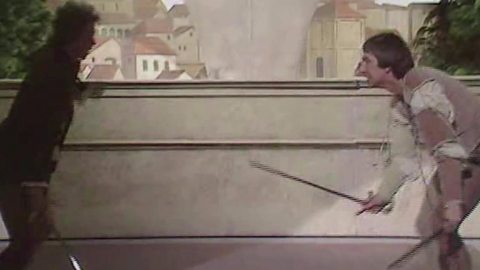
�������� Television Shakespeare Romeo and Juliet: Fight Scene
Romeo fights and kills Tybalt (Alan Rickman)
Meanwhile Juliet’s father decides Paris can now marry Juliet, not knowing that she has already wed Romeo. To frustrate this Friar Laurence, who has helped the lovers and married them, gives Juliet a potion that mimics the effect of death, with the intention that she could appear dead and later elope with Romeo. A message is sent to Romeo telling him of the plan, but tragically it never gets to him.

Juliet drinks the potion and appears to die. She is taken to the family crypt, where Paris mourns her. But Romeo hears that she has died and deciding to die alongside her he obtains poison. He then goes to the crypt, where he encounters Paris. They fight, and Romeo kills Paris. Romeo takes the poison – but then Juliet wakes up as Romeo dies. In despair she kills herself with Romeo’s dagger.
The tragedy of love and death are given full rein in the �������� Shakespeare version.

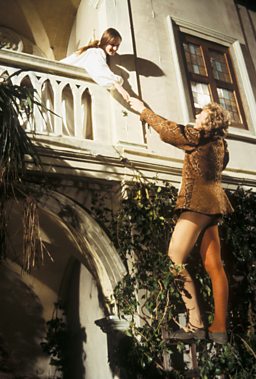
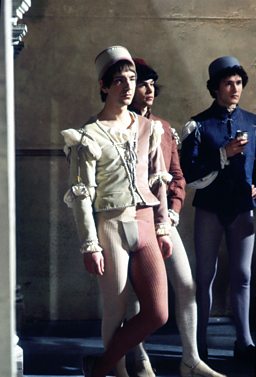
Shakespeare's Influence in Music and Culture
It is perhaps not surprising that this most emotional of love stories should prove highly popular in the period of Romanticism, the European artistic and literary movement that arose in the late eighteenth century and was dominant through the nineteenth century to the early twentieth century. The term ‘romantic’, used in opposition to earlier more restrained ‘classical’ forms (and describing a world view far wider than matters of love), was particularly important in music, which was seen as the art form best suited to the expression of emotions. Shakespeare’s tragic tale of love and loss became particularly popular with composers.
Bellini I Capuleti e I Montecchi
The Romeo and Juliet story was very popular in Italy, and there were libretti based on the story by Luzzi (1785), Foppa (1796), and Buonaiuti (1810). Luigi Scevola wrote the play Giuletta e Romeo in 1818, on which Felice Romani based the libretto that Vincenzo Bellini was to use for his 1830 ‘tragedia lyrica’ entitled I Capuleti e I Montecchi.
The balcony scene involves not just declarations of love but Romeo failing to persuade Juliet to elope at once. Other plot variations are more significant...
This opera was performed in Venice and promptly made the composer’s reputation. In fact however its plot is based more on the 1550s Bandello source that Shakespeare used than on Shakespeare directly. There are some plot differences, but the main thrust of the story is the same.
The balcony scene involves not just declarations of love but Romeo failing to persuade Juliet to elope at once. Other plot variations are more significant: Tebaldo (Tybalt) survives for instance, his fight with Romeo halted by the sound of a funeral dirge for Juliet. Romeo begins the scene not grieving for Mercutio but drunk and despairing.
I Capuleti e I Montecchi (Balcony Scene)

In 2016 the radical opera group Pop Up Opera staged the work as a twentieth century story of feuding mafia families, performing it in unusual locations such as the crypt-like setting of London’s Brunel Thames Tunnel Shaft. Scenes were filmed specially for this Shakespeare Lives project. Romeo is sung by a mezzo-soprano – this is not radical directing but in fact faithful to Bellini who wrote it as a so-called ‘’.
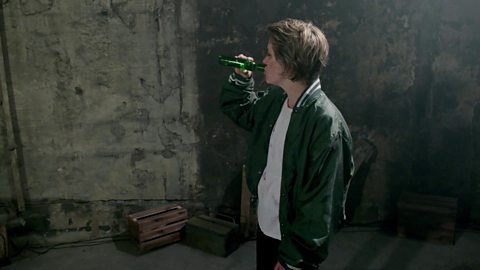
Bellini's 'I Capuleti e i Montecchi' (The Capulets and the Montagues): Romeo and Tebaldo Fight
From the Italian Opera by Vincenzo Bellini, performed by Pop Up Opera

The story takes its tragic course, with Juliet taking a potion that mimics death, Romeo not getting the message that Juliet was doing this in order to be with him, and Romeo coming to the crypt, seeing Juliet apparently dead and fatally poisoning himself. Juliet however does not then die – the opera ends with her slumped in despair over the body of her poisoned lover. In the Pop Up Opera scene this is especially moving as the naturalistic acting abilities of the protagonists combine with strong singing and a poignant score to create a powerful climax.
About Pop-up Opera
is an innovative touring opera company who produce fully staged productions which are then adapted to each new space they go into, making every performance unique. Some of the unusual venues where they have performed include a boat made of scrap metal, a restored Victorian poorhouse, a cylindrical shaft beneath the Thames, a cider barn, a winery and even 100 ft underground in candlelit caverns!
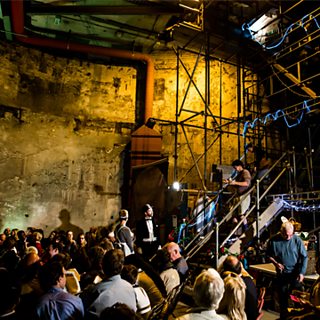
In 2015 they starred as the fictional 'Magic Opera Company' on
Berlioz
The first major French musical interpretation of Shakespeare’s play was inspired by a production by Garrick in London in 1827. The French composer Hector Berlioz saw it and fell instantly in love with the actress playing Juliet, Harriet Smithson. They married in 1833, and in 1839 Berlioz completed his operatic symphony Romeo at Juliette. It is mostly orchestral until the finale, when the vocal parts come out in force. Hector and Harriet’s own lives did not continue as star-crossed lovers: while neither died as a result of their love, the marriage didn’t last either thanks to Berlioz having an affair.
Listen to Berlioz' Romeo and Juliet at the �������� Proms
-
![]()
Orchestre Révolutionnaire et Romantique conducted by Sir John Eliot Gardiner
Gounod's Romeo et Juliette
More familiar to modern audiences than the Berlioz piece is the opera Romeo et Juliette by another Frenchman, Charles Gounod. Its librettists Jules Barbier and Michel Carré modelled the story directly on Shakespeare’s play, and though Gounod reportedly had trouble with the final act, in the end composing it twice, it was an immediate success on its premiere in 1867 in Paris, and has since entered the canon.
Real-life husband and wife Roberto Alagna and Angela Gheorghiu performed Gounod's Romeo et Juliette memorably on film in 2003.
While Alagna and Gheorghiu’s genuine love shines through in the balcony scene, other qualities were required elsewhere.
Early in the filming Roberto Alagna badly twisted his ankle, and as even walking was painful and difficult it was thought necessary to use a stunt double in the energetic fight scene with Tybalt. When the scene came to be shot however the tenor determined to perform the scene himself, and somehow managed to run, fight and escape despite the pain and damage to his joint. Heroic acting, indeed.
The Balcony Scene from Gounod's Romeo et Juliette
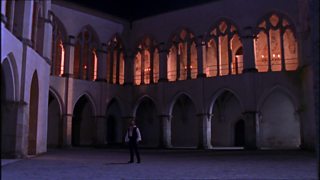
Starring Roberto Alagna and Angela Gheorghiu.
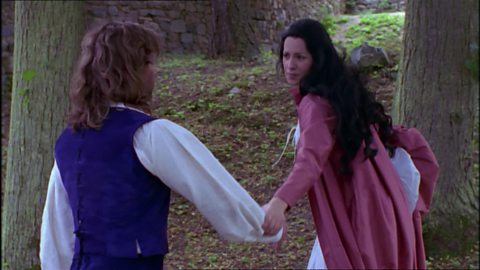
Gounod's opera Romeo et Juliette: Romeo and Tybalt Fight
Romeo (Roberto Alagna) and Juliette (Angela Gheorghiu) recorded at Zvikov castle
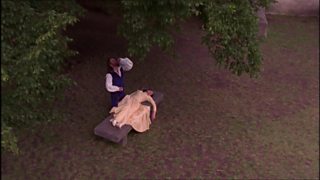
Perhaps the only significant departure from Shakespeare in Gounod’s opera is in the final scene, where Romeo and Juliet are conscious together for long enough to share a final duet before both dying – an understandable amendment by a composer who had already given the doomed lovers three duets earlier in the piece. The film version takes the scene away from the tomb to a beautiful outdoor location, a romantic gesture by the director mirroring the romanticism of Shakespeare’s play and Gounod’s music.
Prokofiev's Romeo and Juliet
The influence of the Romeo and Juliet story was not restricted to Western Europe. In Russia Pyotr Ilyich Tchaikovsky wrote an orchestral work based on Shakespeare’s play, which he styled a Fantasy Overture. Sergei Prokofiev composed the ballet Romeo and Juliet in 1935. It was written to a synopsis by Adrian Pyotrovsky and Sergei Radlov based on Shakespeare’s play.
Such intensity that you sense the whole of the ensuing tragedy hovering over their heads
The 2007 Royal Ballet version with choreography by Kenneth Macmillan featuring Carlos Acosta and Tamara Rojo was widely acclaimed, not just for the music and choreography but for the chemistry between the two lovers, the elegance of Acosta’s Romeo combined with the girlish desire of Rojo’s Juliet, particularly in the balcony scene described by one reviewer as resonating “with such intensity that you sense the whole of the ensuing tragedy hovering over their heads”.
More Romeo and Juliet at the �������� Proms
-
![]()
Tchakovsky Fantasy-Overture 'Romeo and Juliet'
-
![]()
Prokofiev: Romeo and Juliet - excerpts
-
![]()
Readings from Shakespeare and his contemporaries including the Sonnets and famous speeches from Romeo and Juliet

Prokofiev's Romeo and Juliet ballet: Balcony Scene
Romeo (Carlos Acosta) and Juliet (Tamara Rojo)
In this version Tybalt (Thiago Soares) is played not as an angry villain but as a man whose family pride inflames him, and his swordfight with Romeo is enthralling.
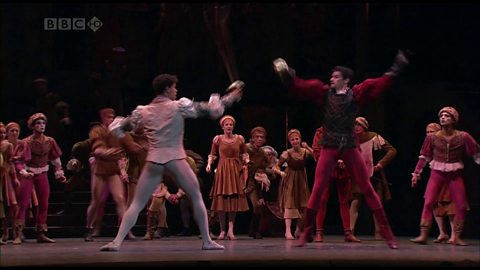
Prokofiev's Romeo and Juliet: Fight Scene
Romeo (Carlos Acosta) and Tybalt (Thiago Soares)
Prokofiev’s ballet was originally given a happy ending, which proved controversial among the Soviet Union’s cultural officials and resulted in the work not being performed at all. After a little persuasion Prokofiev restored the story’s doom-laden ending, and eventually the ballet (in the form we recognise it today) was staged at the Kirov Ballet in 1940. It is arguably as moving in the wordless dance as in the Shakespeare text, or the operatic interpretations of the story by Bellini or Gounod.

Prokofiev's Romeo and Juliet ballet: Death Scene
Romeo (Carlos Acosta) and Juliet (Tamara Rojo)
It is perhaps the cathartic power of Shakespeare’s ending which more than any other factor has made the story of these two lovers so affecting to so many people in so many countries for so many generations.
More on Shakespeare...
-
![]()
Experience an incredible commemoration of the Bard's 400th death anniversary with videos feauring David Tennant, Ian McKellan, Adrian Lester and more
-
![]()
A great collection of actors, authors, writers, including Russell T Davies, Germaine Greer and Salman Rushdie, celebrating the Bard at the arts and literature gathering
-
![]()
Watch some of the most memorable Shakespeare speeches, as chosen by the RSC, featuring Peggy Ashcroft, Patrick Stewart, Vanessa Redgrave and more
-
![]()
From the Bard's influence on pop music to his face appearing on a £20 banknote, discover more unorthodox and unusual tales of Shakespeare from past to present







